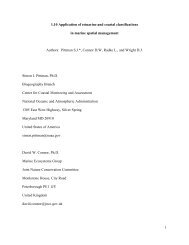Seamounts, Ridges, and Reef Habitats of American Samoa
Seamounts, Ridges, and Reef Habitats of American Samoa
Seamounts, Ridges, and Reef Habitats of American Samoa
- No tags were found...
Create successful ePaper yourself
Turn your PDF publications into a flip-book with our unique Google optimized e-Paper software.
<strong>Seamounts</strong>, <strong>Ridges</strong>, <strong>and</strong> <strong>Reef</strong> <strong>Habitats</strong> <strong>of</strong> <strong>American</strong> <strong>Samoa</strong> 803p0145p0150sea stars (Choriaster granulatus). At the floor <strong>of</strong> the canyon, in the broad depression/open bottom habitat class, a notable discovery was the batfish (Ogcocephalidae) <strong>and</strong>the black-blotched stingray (Figure 58.9), as well as sightings <strong>of</strong> the deep water grouper(Epinephelus timorensis) among many other fish species.Dive P5–650 returned to Taema Bank to investigate the full extent <strong>of</strong> the sheercarbonate wall encountered on P5–648, <strong>and</strong> hence was below the depth <strong>of</strong> priorbenthic terrain classifications. Upon finding the base <strong>of</strong> the wall at 440 m, a video<strong>and</strong> photographic survey proceeded north from that point along that contour, wherea preponderance <strong>of</strong> galatheid <strong>and</strong> hermit crabs, urchins, shrimp, a s<strong>of</strong>t corals, seacucumbers, <strong>and</strong> small stars were noted. Farther up the bank at ~115 m (broad flathabitat class), a large province <strong>of</strong> foraminifers in calcareous s<strong>and</strong>s was noted: genusCycloclypea, the largest in the world.All three dives were extremely successful, with a cumulative bottom time <strong>of</strong> 18 h<strong>and</strong> identification at both sites <strong>of</strong> 32 species <strong>of</strong> invertebrates <strong>and</strong> 91 species <strong>of</strong> fish, atleast nine <strong>of</strong> which are “new records” for <strong>American</strong> <strong>Samoa</strong> (Figure 58.9). The base <strong>of</strong>extensive live bottom for Taema Bank (coral cover <strong>of</strong> 20% <strong>and</strong> greater) was identifiedat a depth <strong>of</strong> 36 m. Alternating sections <strong>of</strong> carbonate reef <strong>and</strong> basalt were observed at~185–220 m depth along both the east <strong>and</strong> west walls <strong>of</strong> Fagatele Canyon, <strong>and</strong> large,grooved, mass-wasting scarps were noted at ~300–400 m depth near the base <strong>of</strong> thesouth central wall <strong>of</strong> Taema Bank. No evidence <strong>of</strong> eutrophication or slurry from PagoPago harbor was seen on the south side <strong>of</strong> Taema Bank. Complete species lists, divetrack maps, <strong>and</strong> cruise report are available in Wright [41].s0030p0155SurrogacyAt this time, no statistical analyses have been carried out on these data sets to examinerelationships between physical surrogates <strong>and</strong> benthos. We await additional video<strong>and</strong> photographic surveys.s0035p0160p0165AcknowledgmentsWe thank captains, crew, <strong>and</strong> scientific personnel aboard the several ships who have beenresponsible for obtaining bathymetric data throughout the Eastern <strong>Samoa</strong> region.Special thanks to Nancy Daschbach, former manager <strong>of</strong> the Fagatele Bay National MarineSanctuary, for providing travel funding over the years via the NOAA National MarineSanctuary Program. Thanks also to Joyce Miller, Emily Lundblad Hirsch, <strong>and</strong> Scott Ferguson,NOAA Coral <strong>Reef</strong> Ecosystem Division/Pacific Isl<strong>and</strong>s Benthic Habitat Mapping Center/Pacific Fisheries Science Center, as well as to Peter Craig <strong>of</strong> the National Park <strong>of</strong> <strong>American</strong><strong>Samoa</strong> for helpful discussions. The manuscript benefited greatly from the comments <strong>of</strong> ananonymous reviewer <strong>and</strong> Robin Beaman <strong>of</strong> James Cook University. This work was supportedin part by the US NOAA-National Undersea Research Program Hawai’i Undersea ResearchLaboratory <strong>and</strong> the US National Science Foundation.
















